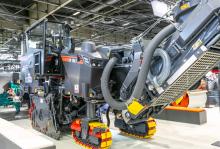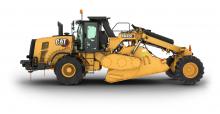Sophisticated new technologies for the road milling market are now coming to market from a number of the key manufacturers in the sector. Astec, Caterpillar and Wirtgen are introducing updated machines, while Italian attachment specialists FAE and Simex are offering innovations for their respective ranges.
Astec’s updated RX-405 machine is the latest version of this 21tonne class milling machine. Power now comes from a Cummins L9 diesel rated at 321kW that meets stage V/Tier 4 Final emissions requirements. The firm says that key benefits are the improved visibility of the working edges as well as safety due to the CCTV cameras placed in key areas around the machine. These allow the operator to ensure that no personnel are in the working zones, while also allowing more accurate working. The machine can handle cutting widths from 610-1,500mm and to depths of 330mm.
Caterpillar is updating its smaller PM310, PM312 and PM313 mills as well as the top-of-the-range PM600 and PM800 models. The firm says that its PM 300 Series machines are aimed at small-medium applications and are designed to be manoeuvrable and versatile, with high production output for their size.
The PM300 models are powered by the Cat C9.3B diesel, which delivers 256kW, an increase in power and torque, while meeting the Tier 4 Final/Stage V emissions requirements. The engine is simpler, also benefiting from improved electronic, fuel and air systems.
A new CCTV system allows the operator to monitor to check the position of the cutting edge while better LED lighting improves working in low light conditions. The redesigned conveyor system is said to reduce material spillage and build-up on the frame, while dust control has been improved.
The larger PM600 and PM meanwhile benefit from the addition of Caterpillar’s sophisticated VisionLink Productivity system, which provides near real-time asset and jobsite data. The system is available for the PM620, PM622, PM820, PM822 and PM825 milling machines. The system collates, analyses and summarises data such as time spent waiting for trucks, cutting and travel at the jobsite as well as distance cut, fuel burn, location and cycle mapping. This gives contractors insights into jobsite productivity and equipment utilisation.
Contractors have access to key data and can track the hours and distance milled/day. Details such as excess travel, slow milling speeds and stoppages can be highlighted. The system removes the need for manual data gathering and provides reports in PDF, Excel and CVS formats for email delivery.
Customers can measure performance, reduce fuel consumption and compare operations between shifts, machines and projects. By reducing downtime, users can achieve more productive milling, improved estimating for future projects, and increased efficiency.
Cloud-based, the VisionLink Productivity platform collates machine telematics and jobsite data from the jobsite. This can be accessed by a smartphone, tablet or desktop device. And fleets with mixed OEM equipment brands can be incorporated into VisionLink Productivity.
From Wirtgen comes the upgraded W 150 Fi planer, a mid-sized machine that benefits from technology first seen in the firm’s larger mills. Power comes from a 9litre John Deere diesel delivering 313kW that meets the Tier 4 Final/Stage V emissions requirements.
The machine is designed to cut a 1.5m width to a depth of 330mm, though it can be fitted with different width drums as well as a range of tooth patterns to suit the needs of the application.
Key features of this mill are the enclosed cab option and sophisticated Mill Assist package, both of which are proven on the larger planers in the range. The advanced Mill Assist system is of particular benefit as it help optimise performance. A spokesperson for the firm said, “Now we’ve put it into the compact machine too.
The spokesperson explained that the new performance tracker capabilities allow the user to monitor the area being cut, tonnage of material being removed and the quantity of material going into each truck. He said, “The performance tracker takes care of all that job data. We can see live data from the machine at the site and its performance on our smart phones.”
The W 150 Fi planer is said to be versatile and with its new John Deere engine, offers better integration of power and torque to performance, delivering a 30% gain in efficiency. Meanwhile dual fans ensure efficient cooling and make it quieter in operation, while improved cutter drum efficiency means it uses less water, allowing paving to be carried out closer afterwards.
Also from Wirtgen is the versatile new W 220 XFi cold milling machine, which can handle a range of duties from surface layer rehabilitation to asphalt removal. The advanced Mill Assist system helps optimise performance by selecting the operating parameters with the most favourable balance between milling performance and operating costs. The W 220 XFi uses a Multiple Cutting System for milling widths from 2.2-3.8m, while the design allows users to switch milling drums and milling drum assemblies quickly.
Using the latest engine technology from John Deere and the group’s Dual-Shift powershift transmission, the machine meets the latest Stage 5/Tier 4 Final exhaust emission standards, without requiring DEF. The 18litre John Deere JD18L diesel has high torque and provides 627kW even at engine speeds of only 1,500rpm.
The Dual-Shift transmission allows high torque to be used at low rpm for optimal milling performance. Even at low engine speeds, high milling drum rotation speeds can be achieved. The unit also features the Mill Assist machine control system, which increases milling performance while reducing diesel and water consumption as well as pick wear.
At the upper speed range, an optimum milling pattern can be attained. The operator can also select one of three operating strategies: ‘ECO’, ‘performance-optimised’, or ‘milling pattern quality’.
The Mill Assist machine control system and Wirtgen’s Group Performance Tracker Milling (WPT Milling) system have already been used in the other F-Series cold milling machines. These systems have been further developed to include a CO2 emissions display.
The carbon emissions in relation to milling can be viewed on the control screen. The automatically-generated WPT report can also include the CO2 emissions of the entire project in addition to other construction-relevant data. Different construction projects can be compared in terms of carbon emissions, allowing conclusions to be drawn for optimising the next project.









